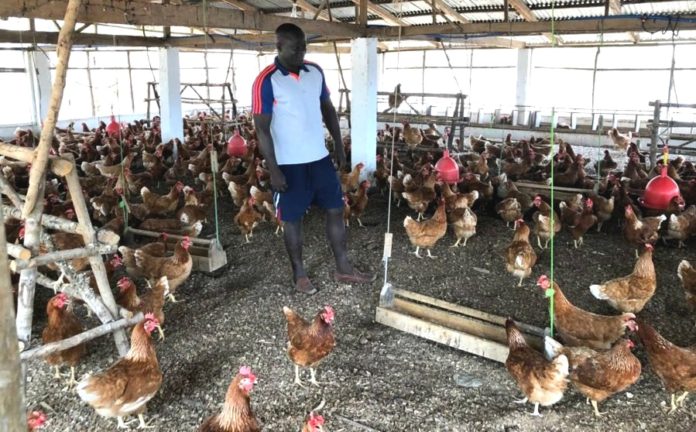Ghana currently imports over US$ 300 million (about 180,000 mt) worth of chicken annually or the equivalent of 5 million chickens each week. The country’s production equates to about 58,000 mt whereas national demand is about 400,000 mt, reports from the Business Insider.
“There was a decline in both eggs and chicken meat production in 2009 and 2010 and thereafter, increased steadily from 50,895 tonnes in 2011 to 59,653 tonnes in 2017, an increase of 17% within 7 years” it explained.
Commercial poultry production in Ghana can be categorized into large-scale (over 50,000 birds), medium-scale (10,000 to 50,000 birds), and small-scale (less than 10,000 birds), and normally farms are owned by individuals or a family.
According to a report by the Ghana Poultry Project, there are 29 large-scale commercial poultry farms currently in Ghana and mostly found in the Ashanti region (13), Brong Ahafo (12), and the Greater Accra region (4). These form about 20 percent of the total poultry sector, producing mainly eggs.
Most of the commercial poultry farmers produce broiler birds for sale only during the festive seasons (Christmas, Easter, Eid ul Fitr, Eid ul Adha) when Ghanaians buy live chickens.
Currently, there is limited regulation on local hatcheries. The Government of Ghana is yet to pass into law a hatchery bill, which will ensure that quality day-old chicks are produced from domestic hatcheries. Who is responsible?
Feed production
Ghana’s poultry feed industry has shifted to producing layer feed due to the drop-off in domestic broiler production. About 80 percent of feed produced by commercial feed millers is layer feed. Broiler feed is primarily purchased by small-scale backyard poultry producers.
However, there is a seasonal feed demand from the larger producers who raise birds for the festive seasons. Poultry feed accounts for about 70 percent of total animal feed produced in Ghana.
Feed manufacturers in Ghana can be categorized into commercial feed millers and on-farm self-millers.
“Ghana has about 17 commercial feed mills with a total installed operating capacity of 1,000 metric tons (MT) per day. However, most feed millers are only producing at about 40 to 50 percent of their capacity due to low demand from the local poultry industry. The average amount of compound feed produced in Ghana is about 10,000MT annually in the past few years” according to the Ghana Poultry Project
Commercial feed millers supply poultry feed mostly to medium- and small-scale poultry producers because large-scale poultry producers mostly produce their own feed.
Trade
Poultry imports to Ghana keep increasing due to increasing demand and the decline in domestic commercial poultry meat production. Ghana poultry imports are supplied mainly from the United States, Brazil, and the EU.
Institutional Setting.
The Animal Production Directorate (APD) and the Veterinary Services Directorate (VSD) of the Ministry of Food and Agriculture (MOFA) have the oversight responsibility of the Poultry sector and other animals/livestock. Whiles APD oversees production issues, VSD takes care of health. Their roles are to ensure effective and efficient implementation of government policies on livestock and poultry. The APD also controls feed quality both from local and imported sources and collects feed samples from commercial feed millers across the country for analysis.
The control and eradication of diseases are done by the Veterinary Services Directorate of the Ministry of Food and Agriculture through vaccination and quarantine. Importation of day-old chicks and poultry vaccines to Ghana are also controlled by the Veterinary Services Directorate.
Government Policy or Programs.
To support the local poultry industry, in 2013 the Government of Ghana removed customs duties on poultry inputs such as feed, additives, drugs, and vaccines and has facilitated improved access to veterinary services.
Moreover, on the 15th of July 2014, the Broiler Revitalization Project was launched aiming to stimulate local broiler production. As part of the project, a new poultry and livestock import policy were designed to cut down the country’s importation of chicken meat. The policy limits imports to 60 percent, meaning that importers must buy 40 percent of their produce from local sources. The overall objective of achieving 40% local broiler sourcing and 60% imported broiler meat has not been achieved.
In 2017, the Government of Ghana also launched a flagship program, “Planting for Food and Jobs (PFJ)”, aimed at creating food security and produce raw material to feed the agro-processing industries while creating jobs in the process.
According to the Ashanti regional director of the Ministry of Food and Agriculture, the introduction of this program helped the poultry sector to cut down costs and decreased the number of imported feeds in the country; report by Daily Graphic.
On the 25th of June, 2019, the President of Ghana launched the “Rearing for Food and Jobs” campaign aimed at developing a competitive and more efficient livestock industry that will increase domestic production, reduce importation of livestock products, contribute to employment creation, and improve livelihoods of livestock value chain actors.
The government has set an ambitious target to invest in the poultry component of the program as a major step to stop the importation of chicken into the country.
According to the Minister of Food and Agriculture, Dr. Owusu Afriyie Akoto, the poultry component of “Rearing for Food and Jobs” is key to the government of Ghana because Ghana cannot continue to import USD 380 million of poultry meat every year when the country exported chicken to her neighbor 20 years ago: report by Daily Graphic.
Donor interventions in the Poultry Sector
Currently, the only donor supporting the Poultry sector in Ghana is the United States Department of Agriculture through the Ghana Poultry Program. It is a five-year (2015- 2020) project being implemented by ACDI/VOCA and Technoserve to expand local production and processing of poultry meat and eggs in Ghana.
The project aims at increasing the competitiveness of the poultry value chain using an inclusive system approach. The target beneficiaries of the project include processors, input suppliers, financial institutions, business service advisors, and buyers. The project’s interventions are in four areas; capacity building, financial services, training, and market access.
Bottlenecks.
Firstly, it’s no longer profitable to produce poultry products in the country because it ends up being highly expensive, whilst imports cost far less. This is because feed costs which constitute about 70% of overall production costs are unreasonably high in Ghana.
Secondly, the cost of other inputs including medication for the birds is unreasonably high.
Thirdly, the high cost of sources of energy is another big problem for local poultry producers.
Lastly, poultry producers struggle to get the market for their produce because imported chickens are cheaper.
Way forward in dealing with the Bottlenecks in the Poultry Sector
I believe that increased government investments in the sector to produce better-quality day-old chicks and other inputs would really help. The Government must subsidize feed, and strengthen processing, and marketing facilities and ensure there is a stable electricity supply at the production centers at lower costs.
Conclusion.
Ghana’s Agricultural Development Bank has announced a GHC500 million (US$ 87 million) loan facility in support of the government’s Broiler Revitalization Programme aimed at increasing the domestic production of chicken.
Dr. John Kofi Mensah, managing director of ADB, says that GHC25 million (US$ 4.3 million) has been approved for the initial phase of the project, which is for 6 broiler value chain players to produce and process over 100,000 birds weekly. Good news? Have the various interventions and that of the GHC500 million (US$ 87 million) loan achieved its intended purpose? How were the disbursements done? Did ADB consider a market for the birds? Are Poultry farmers enjoying a stable electricity supply?, Did ADB consider the high cost of quality blended feeds?, and Did ADB consider the cost of transporting birds?
Who is responsible?








